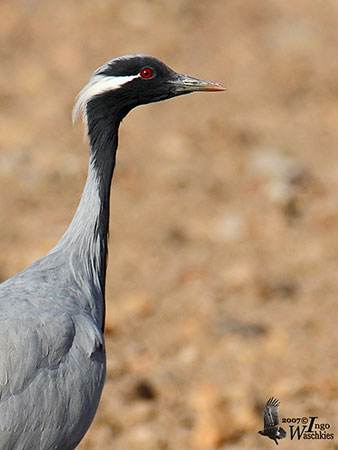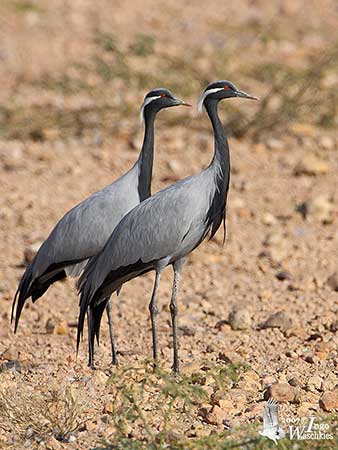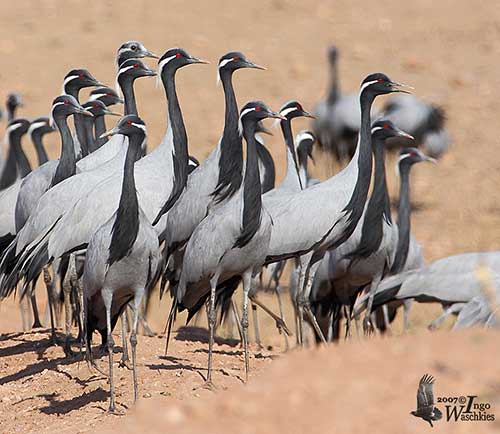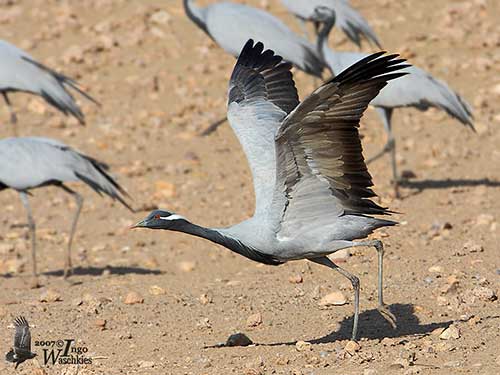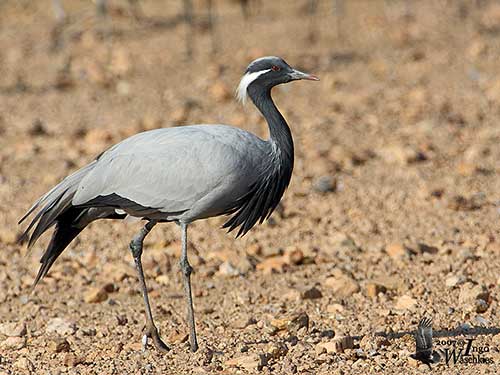
Fr: Grue demoiselle
All : Jungfernkranich
Esp : Grulla Damisela
Ital : Damigella di Numidia
Nd : Jufferkraan
Sd : Jungfrutrana
Photographer:
Ingo Waschkies
My bird pictures on Pbase
Text by Nicole Bouglouan
Sources :
HANDBOOK OF THE BIRDS OF THE WORLD Volume 3 by Josep del Hoyo-Andrew Elliott-Jordi Sargatal - Lynx Edicions - ISBN : 8487334202
ENCYCLOPEDIE DES OISEAUX DE FRANCE ET D’EUROPE – de Peter Hayman et Rob Hume - Flammarion – ISBN : 2082009920
L’ENCYCLOPEDIE MONDIALE DES OISEAUX - Dr Christopher M. Perrins - BORDAS - ISBN: 2040185607
BIRDS OF THE MIDDLE EAST by R.F. Porter, S. Christensen, P Schiermacker-Ansen C.Helm - ISBN: 0713670169
BirdLife International (BirdLife International)
International Crane Foundation
Wikipedia, the free encyclopaedia
Demoiselle Crane
Grus virgo
Gruiforme Order – Gruidae Family
BIOMETRICS:
Length: 90 cm
Wingspan: 150-170 cm
Weight: 2000-3000g
DESCRIPTION:
The Demoiselle Crane is the smallest of the cranes’ species.
This bird is often mentioned in the literature and poetry of Northern India and Pakistan. The graceful appearance of this bird involves numerous comparisons between beautiful women and this crane.
As the Blue Crane, the Demoiselle Crane has entirely feathered head, and lacks the red patches of bare skin very common in others Gruidae species.
The adult has uniform grey body. On the wings, the secondaries are black-tipped. Head and foreneck are black. The foreneck shows elongated black feathers which hang down to the breast.
On the head, the central crown is greyish-white from forehead to rearcrown. We can see white ear-tufts, extending from behind the eye to the nape, formed by elongated white feathers.
The straight bill is grey at base and tipped reddish. It is relatively short. The eyes are orange-red. Legs and feet are black. The short toes allow the bird to run easily on the dry ground.
Both sexes are similar in plumage, but the male is slightly larger than the female.
The juvenile is dull pale grey with almost white head and neck. The ear-tufts are grey and shorter than in adults. The eyes are brown.
VOICE: SOUNDS BY XENO-CANTO
The Demoiselle Crane utters raspy, low-pitched, guttural trumpeting calls “krrllaa-krrllaa…” or “krrlll-krrlll”.
HABITAT:
The Demoiselle Crane frequents open shrubby plains, savannahs, steppes and various grasslands, often close to the water, streams, lakes or wetlands. This species can be found in deserts and semi-desert if water is available.
On the wintering grounds, it uses cultivated areas in India and roosts in the close wetlands. On the African wintering areas, it occurs in thorny savannah with acacias, grasslands and close wetlands.
This bird is visible up to 3000 metres of elevation in Asia.
RANGE:
The Demoiselle Crane breeds in C Eurasia, from Black Sea to Mongolia and NE China.
It winters in Indian Subcontinent and in Sub-Saharan Africa.
Isolated populations occur in Turkey and in North Africa (Atlas Mountains).
BEHAVIOUR:
The Demoiselle Crane forages by walking slowly, and feeds mainly on plant items, but it also takes insects during summer, and worms, lizards and small vertebrates.
During the migration, the large flocks make stopovers in cultivated areas, as in the wintering grounds in India where they can damage the crops.
As all cranes’ species, the Demoiselle Crane performs ritual and beautiful displays, as well in courtship as in social behaviour.
These displays or dances consist in co-ordinated bows, jumps, runs and tossing of plant items in the air.
The Demoiselle Crane’s dances tend to be more energetic than in larger species, and are described as “more-ballet-like” than those of the cranes of genus “Grus”, with less theatrical postures.
The Demoiselle Crane is migratory and travels through the high mountains of the Himalayas, whereas other populations cross the wide deserts of Middle-East and North Africa to reach their wintering grounds.
The small population of Turkey seems to be sedentary within its range.
The migratory flocks can contain up to 400 birds at the beginning, but when they arrive at the wintering areas, they gather in huge flocks of several thousands.
FLIGHT:
The Demoiselle Crane, as other cranes, needs to run on the ground to reach speed and take off. It flies with deep, powerful wing beats, and alight in standing stance after approaching with dangling legs and spread wings and tail. During the migration above the high mountains, it can fly between 5000 and 8000 metres height.
REPRODUCTION:
The breeding season occurs in April-May and until late June in the northern parts of the range.
The Demoiselle Crane nests on the dry ground, on gravel, in open patches of grass or cultivated areas. The pair becomes aggressive and territorial, and defends the nesting areas. They may lure the predators away from the nest with a kind of “broken-wing” display.
The female lays two eggs directly on the ground. Some small stones or vegetation are sometimes gathered by the adults to provide camouflage and protection, but the nest is always a minimal structure.
The incubation lasts about 27-29 days, shared by both adults. The downy chicks are grey with pale brownish head, and greyish-white below.
They are fed by both parents, and they follow the adults very soon after hatching to the nearby foraging areas. They fledge about 55-65 days after hatching, a very short period for large birds.
They usually can breed at two years.
DIET:
The Demoiselle Crane feeds mainly on plant items such as seeds of grasses and cereal grains. They also catch insects such as Coleopteran in summer, but worms, lizards and small vertebrates are included in their diet.
They feed by walking slowly and pecking at the surface.
PROTECTION / THREATS / STATUS:
The Demoiselle Cranes are considered as crop-pest in some parts of the range, where they damage the crops. They are shot or poisoned for this reason.
They are threatened by habitat loss and drainage of wetlands, and suffer hunting pressure. They are killed for food or sport, and Pakistan and Afghanistan performs illegal pet-trade.
The degradation of the habitat occurs across the range in steppes, but also on the wintering grounds and along the migration routes.
Several protection programs are already active in several countries to regulate the hunting and to protect the bird and its habitat.
This species breeds well in captivity.
Currently, the Demoiselle Crane’s populations are not endangered.

